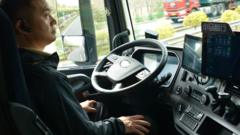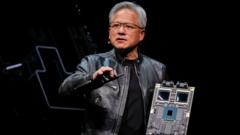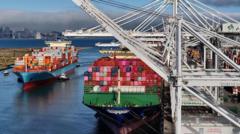China's driverless lorries, equipped for autonomous navigation from Beijing to Tianjin, raise both hope and apprehension about the future of the trucking industry and public acceptance of such technology. Despite assurances from safety drivers and advancements in autonomous technology, concerns remain regarding safety and job displacement as the country pushes forward into this uncharted territory.
Transforming Transport: A Glimpse into China's Autonomous Trucking Future

Transforming Transport: A Glimpse into China's Autonomous Trucking Future
As China ventures deeper into the realm of autonomous vehicles, driverless lorries are paving the way for a revolutionary shift in the transport industry, challenging public perception and regulatory frameworks.
On a busy highway linking Beijing to the port of Tianjin, driverless lorries equipped with advanced navigation systems are set to revolutionize China's transportation sector. Although a safety driver is seated behind the wheel due to government regulations, these trucks are primarily navigating themselves, showcasing impressive yet unnerving technology in action.
Huo Kangtian, a 32-year-old safety driver, recalls the mixture of awe and anxiety when he first relinquished control to the autonomous system. "Of course, I felt a bit scared the first time I drove an autonomous truck," he admits, but he has grown to trust these machines after extensive testing. As the lorry effortlessly maneuvers through traffic and toll gates, Huo remains ready to take control in case of an emergency, reiterating the importance of human oversight even when technology thrives.
Pony AI, the company behind these lorries, envisions an efficient future where transportation costs plummet alongside labor expenses. According to Li Hengyu, the vice-president of Pony AI, the shift towards driverless vehicles is not just about saving money but also about tackling the challenges of long-haul driving in various conditions. Industry expert Yang Ruigang emphasizes that companies are keen to invest in reducing driver costs to virtually zero.
Public perception, however, poses a significant challenge. The industry faced a setback following a tragic accident involving a self-driving vehicle, leaving three students dead. Analyst Chim Lee pointed out that the Chinese population remains skeptical, especially in the wake of similar incidents involving autonomous cars. He believes that before mass adoption can take place, public sentiment must shift favorably, a sentiment echoed by Yang, who anticipates that widespread replacement of drivers isn't imminent.
In Hefei, a city known for embracing technology, hundreds of driverless delivery vans navigate suburban streets. They transport parcels from distribution centers to community hubs, where scooter drivers complete final deliveries. Rino.ai’s president, Gary Huang, highlights the role of government support in experimenting and refining regulations alongside local innovation. Currently, Rino operates over 500 autonomous vans across 50 cities in China, showing considerable promise in the realm of logistics.
While heavy long-haul trucks may still be years away from complete autonomy, experts predict that gradual advancements in technology will lead to their routine use under specific circumstances. They outline immediate applications in remote environments and suggest that technical barriers, including the need for enhanced tracking systems and sensors, need to be addressed.
China's ambition is to lead the world in autonomous technology, but it must also navigate public concern and potential consequences—ranging from traffic safety to employment impacts. As Chim Lee points out, the public's perception of propulsion—the benefits versus the potential dangers—will be vital in shaping the future of autonomous trucks in China. Professor Yang emphasizes that society must reconcile its limited tolerance for machine error with evolving transportation safety standards to achieve a successful transition from traditional to autonomous driving.
















